
Interview with Owner Handler Chris Chapman
Insights from an Owner Handler Chris Chapman. Chris shares his opinions on various topics about dog handling in the modern show ring.

Home » Dog Breeds » Australian Terrier Dog Breed
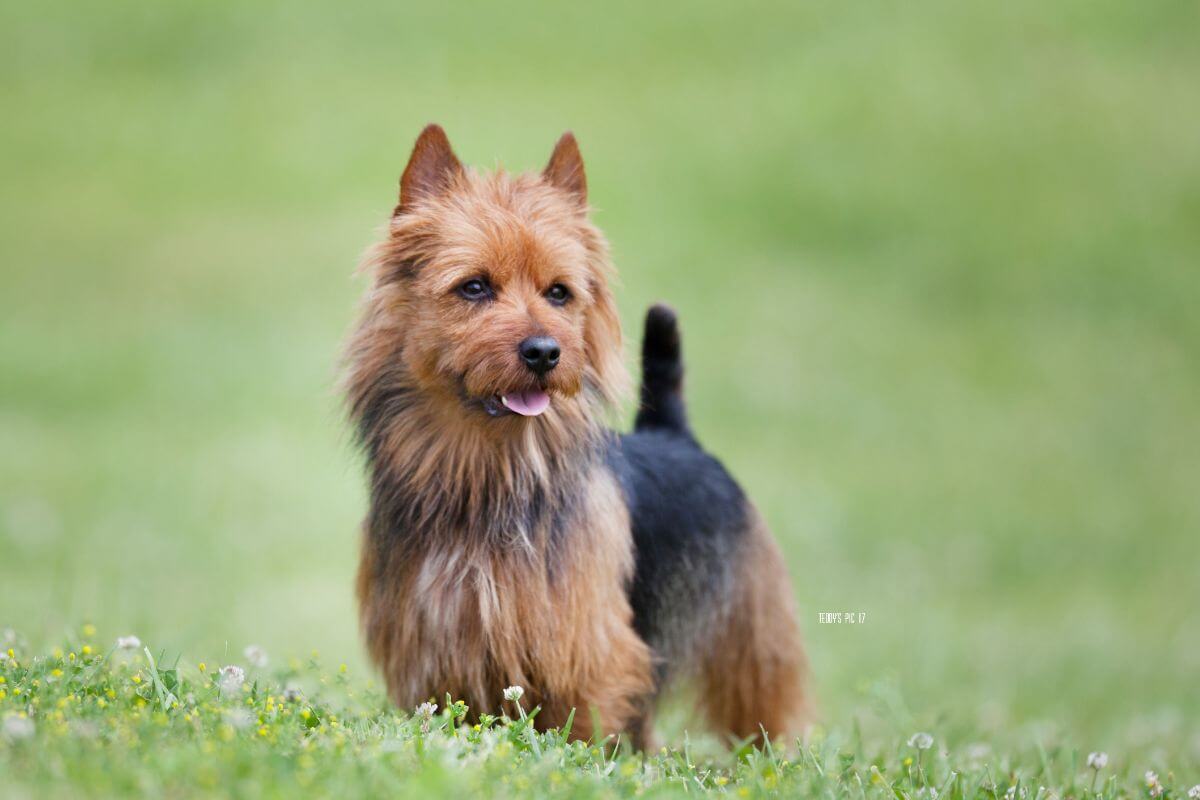
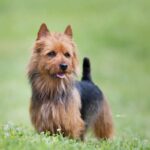


The Australian Terrier was initially bred in Tasmania from various British breeds brought to the land Down Under. The rough-coated terriers were used throughout Australia to control vermin in gold and opal mines, along waterfronts, and on sheep stations. They were even used to herd the sheep and act as watchdogs. This small but robust terrier has been known ever since for its distinctively rugged appearance and its exuberant personality. A proud member of the terrier family, not to be confused with the (Australian) Silky Terrier, the Australian Terrier was developed to navigate the country’s diverse and challenging landscape, and to provide assistance and companionship wherever a small working terrier is needed.
Terrier
10 – 11 inches
15 – 20 pounds
11 – 15 years
| Country of Origin | Australia |
|---|---|
| Bred For | Hunting, Guarding, Companionship |
| Known For | Loyalty, Independence, Alertness |
| Popularity | Low |
| Temperament | Courageous, Affectionate, Spirited |
| Activities | Hunting, Guarding, Running, Walking, Conformation Shows, Dog Sports |
The Australian Terrier holds a distinguished place among the dog breeds developed Down Under, boasting a history that reflects Australia’s own rugged and spirited character. This breed, one of the smallest of the working terriers, was developed in the early 19th century. Its precise ancestry is a blend of various terriers brought from Britain, including ancestors of the Dandie Dinmont, Scottish, and Yorkshire Terriers.
The breed was engineered to adapt to harsh Australian environments that required a dog that could handle both working and companion roles on isolated farms and burgeoning settlements. The dogs were tasked with controlling rodents and snake populations, herding sheep and cattle, and serving as loyal and alert partners.
By the late 19th century, the Australian Terrier’s breed characteristics had been refined and standardized, becoming distinguished from its terrier cousins by its unique coat, color, and size. The breed gained recognition due to its versatility, tenacity, and endearing personality, becoming a cherished member among many Australian farming families.
The Australian Terrier was one of the first breeds from Australia to be officially recognized in other parts of the world, gaining recognition in the United Kingdom in the late 19th century. American Kennel Club recognition came about in 1960. This international support for the breed reflects its universal appeal and its adaptability.
Throughout its history, the Australian Terrier has retained the core attributes that made it so valuable to early Australian settlers: intelligence, courage, and affection. These traits, coupled with the breed’s distinctive appearance and spirited demeanor, continue to endear it to dog lovers around the world, whether in a working capacity, at dog shows, or as beloved family pets.
Adult Australian Terriers typically measure about 10 to 11 inches tall at the shoulder and weigh around 15 to 20 pounds, with females being somewhat smaller than the males.
In terms of proportion, the Australian Terrier presents a slightly longer than tall silhouette. The breed’s substance is solid and muscular, reflecting its strength and endurance. The chest is deep and well-developed, providing ample lung capacity to support vigorous activity. The overall balance of proportion and substance in the breed is crucial, as it contributes to the its capability to navigate diverse terrain and engage in its traditional working and hunting roles with efficiency and vigor.
Texture: The Australian Terrier’s coat is one of its defining features, characterized by a straight, harsh, and weather-resistant topcoat and a shorter, softer undercoat. This double coat offers protection from the harsh Australian climate, providing insulation against both heat and cold. The coat’s texture is not only functional but also contributes to the breed’s distinct appearance, with its rough outer coat that gives the breed its rugged, ready-for-action look. The outer coat is harsh and straight, 2-1/2 inches in length except on the tail, pasterns, rear legs from the hocks down, and the feet which are free of long hair. There is a distinct ruff and apron, and a soft, silky topknot on the head. The hair on the ears is kept short.
| Standard Color | |
|---|---|
| Blue & Tan | ee |
| Red | ee |
| Sandy | ee |
A Note About Color: The coat’s color may be blue and tan, solid sandy, and solid red. Blue may be dark blue, steel-blue, dark gray-blue, or silver-blue. Tan markings (not sandy or red) should be rich and appear on the face, ears, underbody, lower legs and feet, and around the vent. The topknot may be silver or a lighter shade of the head color. Any shade of solid sandy or solid red is acceptable, although the clearer the color the better. The topknot in either of these colors may be silver or a lighter shade of the body coat. All black body coats on adult blue and tan dogs, tan smut in the blue portion of the coat, and dark smut in sandy/red dogs are not desirable, nor are white markings on the chest or feet.
No specific markings are recognized for the Australian Terrier.
The tail of the Australian Terrier is set on high and carried erect, at a twelve to one o’clock position. The tail’s set is a distinctive feature of the breed as it provides a good hand-hold on the mature dog. The tail may be docked to a length of slightly less than one-half. In countries where tail docking is prohibited, the natural tail is either straight or curved forward. Whether docked or undocked, the tail’s set is of primary importance and the carriage should always project the impression of an alertness that aligns with the breed’s working nature.
When considering the Australian Terrier as a companion, there are several important aspects to consider. Prospective owners should be prepared for a dog that is highly energetic, intelligent, and requires plenty of engagement, making it essential to consider the ability to meet the breed’s basic needs.
Generally, the Australian Terrier is known for its longevity and robust health, with an average life expectancy of 12 to 15 years. However, as with any breed, it’s important to monitor each dog’s health throughout its lifetime.
Although this are typically robust dogs, these Aussies can be susceptible to certain health conditions, just like any breed or mixed breed. Owners should be aware of the following health risks:
To maintain the health and well-being of an Australian Terrier, regular veterinary check-ups are recommended as is open communication with the dog’s breeder.
The Australian Terrier is a breed renowned for its spirited and affectionate nature, making it an excellent companion for a variety of owners, including those with little doggy experience. However, understanding the breed’s personality is crucial to ensure a harmonious relationship.
Australian Terriers are known for their loyalty and courage, often forming strong bonds with their family members. They are quite intelligent and eager to please, which can be advantageous during training sessions. Despite the breed’s rather small size, these dogs typically have a large presence and are known to be quite confident and even assertive.
These terriers are generally good with children and can coexist peacefully with other dogs if properly socialized, their strong prey drive means they may not be suitable for households with smaller pets. They are generally friendly towards strangers, but they won’t hesitate to alert their family to anything unusual, making them excellent watchdogs.
The Australian Terrier does not typically like to be left alone for long periods, as these dogs thrive on interaction and activity. Making sure they are part of family activities can help to prevent the development of separation anxiety and the misbehaviors that accompany it. Their adaptability can make them a great choice as a companion, but these Aussies do need adequate exercise to positively channel their energy reserves.
Proper feeding and nutrition are essential for the Australian Terrier’s health and well-being. As a small, energetic breed, this dog requires a balanced diet that supports its high energy levels and nutritional needs throughout each life stage.
For Australian Terrier puppies, a diet rich in high-quality, easily digestible protein is vital for healthy growth and development. Puppies should be fed small, frequent meals to support their rapid growth phase without overburdening their digestive system.
Transitioning to adult food should occur at around one year of age. Adult Australian Terriers typically require a well-balanced diet formulated for small breeds with high energy levels. The exact amount of food, usually measured in cups per day, will depend on the dog’s age, size, activity level, and metabolism. Typically, an adult of this breed might need anywhere from 1/2 to 1 cup of high-quality dry food per day, divided into two meals.
Monitoring the dog’s weight and body condition is crucial, as overfeeding can lead to obesity, which is particularly harmful to smaller dogs. Adjustments to the diet should be made based on the dog’s activity level, health status, and weight changes.
It is important to provide the Australian Terrier with fresh drinking water at all times, Similarly, consulting with a veterinarian to determine the most appropriate food and portion sizes, taking into account any specific health concerns or dietary needs, will enhance the dog’s overall health and longevity.
Training an Australian Terrier can be an enjoyable and rewarding experience due to the breed’s keen intelligence and desire to please their partners. However, like all intelligent dogs, these Aussies require consistent and positive training methods to harness their full potential.
Australian Terriers respond best to positive reinforcement techniques such as treats, praise, and play. These methods not only encourage learning but also strengthen the bond between the dog and its handler. Early socialization and obedience training are crucial for cultivating good manners and adaptability.
Despite the breed’s typical eagerness to learn, Australian Terriers can exhibit a stubborn streak, which necessitates patience and consistency in training. These dogs benefit from varied training sessions that challenge their minds and keep them engaged, thus preventing boredom.
This Aussie’s intelligence and alertness make these dogs excellent candidates for participating in a variety of dog sports and activities. However, their training should also address their natural tendencies, such as a strong prey drive and the inclination to bark, which can be managed with proper guidance and training.
The Australian Terrier is also known for its independent thinking, so it’s essential to establish leadership and clear boundaries. Training should be an ongoing process that continues throughout the dog’s life to make sure this fun-loving partner remains well-behaved and eager to work.
To maintain its physical health and mental well-being, exercise is a crucial component of the Australian Terrier’s daily routine. As an energetic and lively breed, this smart and sassy Aussie requires regular physical activity to channel its energy constructively and to prevent boredom.
| Energy Level | Moderate to High |
|---|---|
| Exercise Requirements | 90 Minutes/Day (Minimum), Daily Walks, Vigorous Running, Regular Exercise, Mental Stimulation |
A daily exercise routine for an Australian Terrier should include walks, playtime, and opportunities for mental stimulation. Walks should be long enough to keep the dog physically active and mentally engaged, exploring new environments and scents. Interactive play, such as fetch or tug-of-war, can also provide both physical exercise and mental engagement.
In addition to physical exercise, Australian Terriers benefit from activities that stimulate their minds, such as training sessions, puzzle toys, and games that require problem-solving skills. These activities help to prevent the development of destructive behaviors that can stem from boredom or excess energy.
Despite their small size, Australian Terriers have a high energy level and enjoy participating in various activities beyond daily walks, including Agility and Obedience Trials, and even engaging in interactive games at home. It’s important to tailor the exercise routine to the individual dog’s needs, considering factors like age, health, and energy level.
Providing a balanced mix of physical and mental exercise will help the Australian Terrier remain healthy, happy, and mannerly, reducing the likelihood of behavioral issues and promoting a strong bond between the dog and its partner.
Grooming is an essential aspect of caring for an Australian Terrier, impacting both the dog’s appearance and its health. While these dogs are not excessively high-maintenance, their grooming routine should be consistent and thorough enough to keep them looking their best and to identify any underlying skin or health issues early on.
| Coat Type | Double, Harsh, Straight, Medium Length |
|---|---|
| Grooming Requirements | Weekly Brushing, Occasional Bathing, Monthly Nail Trimming, Weekly Tooth Brushing |
The coat of an Australian Terrier is double-layered, with a harsh, straight topcoat and a soft, short undercoat. Regular brushing, at least once a week, is recommended to remove the loose hair, prevent matting, and distribute the skin’s natural oils throughout the coat. This helps to maintain the coat’s natural luster and weather-resistant qualities.
Bathing should be done only as needed, typically every few months, unless the dog gets particularly dirty. Over-bathing can strip the coat of its natural oils, so using a dog-specific shampoo that maintains the coat’s health and condition is crucial.
In addition to coat care, Australian Terrier grooming includes regular nail trimming to prevent both discomfort and mobility issues. The ears should also be checked weekly for signs of irritation, and the ear canals should be kept clean and dry.
Dental hygiene is also a vital part of any grooming regimen. Regular tooth brushing with a canine-formulated toothpaste can prevent tartar buildup and gum disease, contributing to the mouth’s overall health and mitigating bad breath.
Consistent grooming not only keeps the Australian Terrier looking presentable, it also provides an opportunity to strengthen the bond between the dog and its handler. Grooming allows the handler to check for any concerning symptoms, such as lumps, bumps, or skin irritations. This will ensure that any concerns are addressed promptly.
Living with an Australian Terrier can be a delightful experience, as this breed is known for its affectionate, lively, and spirited personality. However, understanding and accommodating each dog’s specific needs is crucial to ensure a harmonious cohabitation.
Most Australian Terriers are adaptable and can thrive in various living environments, including apartments, provided they receive sufficient exercise and mental stimulation. The breed’s small size can make these dogs convenient companions for smaller living spaces, but their energy and intelligence mean they require regular engagement and activity, regardless of the size of the home.
These terriers are well-suited to various climates, but like all dogs, they should be protected from extreme weather conditions. In hot temperatures, it’s essential to provide ample shade and water, and in colder climates, a coat or sweater may be needed while enjoying outdoor activities.
Although Australian Terriers are generally good with children and can coexist with other pets if properly socialized, their terrier nature means they may enjoy chasing smaller animals. Early socialization and training are crucial to mitigate this instinct and promote peaceful interactions.
Their alertness can make Australian Terriers excellent watchdogs, as they are quick to alert their families to any unusual occurrences around the house and in the home. However, this trait should be managed with training to prevent excessive barking from becoming a chronic problem.
Regular grooming, exercise, and veterinary care are essential for maintaining an Australian Terrier’s good health and well-being. Additionally, providing a structured environment, with clear rules and routines, can help to make this spirited and self-assured dog feel secure and content in any situation.
The arrival of a litter of Australian Terrier puppies is the beginning of an exciting adventure, but it’s also a significant commitment that requires preparation and understanding of the little ones specific needs during this vital developmental stage.
When caring for an Australian Terrier puppy, it is crucial to provide a safe, nurturing environment that promotes healthy growth and development. From the moment the puppy arrives in its new home, it’s important to establish a routine that includes regular feeding, potty breaks, and sleep schedules. Consistency in these areas helps the puppy feel secure and aids in housetraining.
Feeding the Australian Terrier puppy a high-quality diet formulated for small-breed puppies is essential to support rapid growth and energy needs. It’s important to make sure the food is appropriate for the pup’s age, size, and activity level, and to follow the recommended feeding guidelines.
Socialization is another critical aspect of puppy care. By exposing the Australian Terrier puppy to various people, environments, and other animals in a positive, controlled manner will encourage emotional well-being and can prevent fearful or aggressive reactions later in life.
Basic training should begin early, using positive reinforcement methods to teach fundamental commands and manners. Early lessons will lay the foundation for good behavior and they will strengthen the bond between the pup and its favorite person.
Regular veterinary check-ups are vital during this stage to monitor the Australian puppy’s health, administer necessary vaccinations, and address any concerns. Additionally, implementing a routine grooming regimen early on can acclimate the pup to being handled and will make caring for the coat, nails, ears, and teeth a stress-free experience.
The Australian Terrier is an energetic and agile dog with a keen intelligence that makes this Aussie original well-suited for a variety of activities and dog sports. Engaging these dogs in a variety of activities not only taps into their natural instincts and abilities but also provides valuable mental stimulation and physical exercise, strengthening the bond between dog and owner.
These activities can provide mental and physical engagement for the Australian Terrier, helping to prevent boredom and behavioral issues while enhancing their quality of life. Participation in dog sports and activities also offers great opportunities for socialization with other dogs and people.
The Australian Terrier is recognized by the world’s leading registries and kennel organizations, which categorize the breed into a specific Group based on its unique characteristics. This breed is recognized worldwide under the following Group designations:
| Organization | Group Designation |
|---|---|
| AKC (American Kennel Club) | Terrier |
| UKC (United Kennel Club) | Terrier |
| CKC (Canadian Kennel Club) | Terriers |
| ANKC (Australian National Kennel Council) | Terriers |
| RKC (The Royal Kennel Club) | Terrier |
| FCI (Fédération Cynologique Internationale) | Group 3: Terriers; Section 2: Small-Sized Terriers |
The ideal Australian Terrier is described by a Breed Standard that is approved by each of the world’s leading registries and kennel organizations. The Breed Standards for this breed may be found in the following links:
| Organization | Breed Standard |
|---|---|
| American Kennel Club | AKC Australian Terrier Breed Standard |
| United Kennel Club | UKC Australian Terrier Breed Standard |
| Canadian Kennel Club | CKC Australian Terrier Breed Standard |
| Australian National Kennel Council | ANKC Australian Terrier Breed Standard |
| The Royal Kennel Club | RKC Australian Terrier Breed Standard |
| Fédération Cynologique Internationale | FCI Australian Terrier Breed Standard |
Australian Terrier Clubs play a pivotal role in bringing together enthusiasts of the breed, offering a platform for education, camaraderie, and breed advocacy. These organizations are instrumental in promoting the breed, organizing events, and supporting breed-specific research and rescue efforts.
The Australian Terrier Club of America (ATCA), founded in 1957, stands as the central organization for those who are passionate about the breed in the United States. The ATCA organizes events, including Specialty shows and educational seminars, fostering a sense of community and shared purpose among its members.
In the United Kingdom, the Australian Terrier Club of Great Britain serves as the cornerstone for breed enthusiasts. This club is committed to the promotion and betterment of the breed, organizing events that include breed shows to casual gatherings, each aimed at celebrating and supporting this unique terrier.
Membership in these clubs offers numerous benefits, including access to information, participation in events, and opportunities to connect with other fans of the Australian Terrier. Clubs also play a critical role in advocating for the breed, supporting ethical breeding practices and educating the public on the breed’s unique characteristics and needs.
Dedicated Australian Terrier rescue groups operate in several countries to support and rehome terriers that find themselves without a family to call their own. These organizations are vital in providing necessary care, love, and a second chance for these outgoing and useful terriers.
In the United States, Australian Terrier Rescue is a well-regarded organization committed to the breed’s welfare, assisting dogs across the country. The group’s volunteers work diligently to place Australian Terriers into loving homes, ensuring each dog receives the attention and care it deserves.
For those who are thinking about bringing an Australian Terrier into the home, contacting these rescue groups and local shelters can be helpful. These organizations may occasionally have an Aussie or Aussie mix in need that is just waiting for someone to provide a caring and loving home.
Australian Terriers are excellent pets, known for their loyalty, affection, and spirited nature. They adapt well to various living environments, making them suitable for apartment living and houses with big yards. Their size and engaging personality also make them great companions for families, singles, and seniors alike, offering a balance of energy and manageability.
No dog breed is truly hypoallergenic, including the Australian Terrier. However, these dogs are considered to be relatively low shedders. This can make them a suitable option for people with mild allergies. Regular grooming can help to minimize the shedding and keep dander in check, but it’s always best to spend time with the breed before making a decision to bring one home.
Australian Terriers do shed, but their shedding is relatively minimal compared to other breeds. Their coat requires regular grooming to stay clean and healthy, which can also help to reduce the amount of hair that’s shed around the house. Weekly brushing is usually sufficient to keep the shedding under control and maintain the coat’s condition.
Australian Terriers typically enjoy a long lifespan, often living between 11 and 15 years. With proper care, including regular veterinary check-ups, a nutritious diet, and adequate exercise, these terriers can happily live a full and vibrant life. Their longevity is a testament to their robust nature and adaptability.
Australian Terriers are not inherently aggressive; they are known for being friendly and affectionate with their families. Like any dog, however, they can develop behavioral issues without proper training and socialization. Early socialization, training, and positive reinforcement are crucial to make sure that they grow up to become well-adjusted adults.
The Australian Terrier is not known for overeating. However, to prevent obesity, it’s essential to feed meals that are appropriately portioned. Regular exercise and monitoring the dog’s food intake, based on size, age, and activity level, will help to maintain good overall health.
Australian Terriers can be vocal, but they don’t necessarily bark excessively. They will alert their human companions to anything unusual, making them excellent watchdogs. Proper training can help to manage the vocalizations, ensuring they only bark when necessary and understand when to be quiet.
While individual preferences can vary, many Australian Terriers enjoy water and can be good swimmers. They may not have the same affinity for water as some breeds that are known for their swimming prowess, with positive introductions, they can safely enjoy many water activities.
Australian Terriers were originally bred for hunting rodents and snakes, aiding farmers in protecting their land and their livelihood from infestations. The breed’s tenacity, courage, and intelligence have made them excellent at these tasks. Over time, these Aussies have adapted to various roles, but they still retain the hardy, energetic, and determined nature that was valued in their working past.

Insights from an Owner Handler Chris Chapman. Chris shares his opinions on various topics about dog handling in the modern show ring.

Interview with Kerry Lee 2023 MCKC Dog Show Breed Judge. Read about his experience with judging at the prestigious dog show.
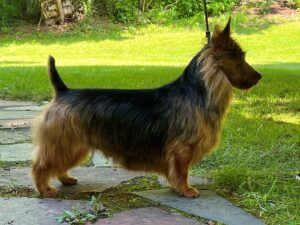
Australian Terrier proportions: A guide to their structure, agility, and nature. Discover the key characteristics of this spirited breed.
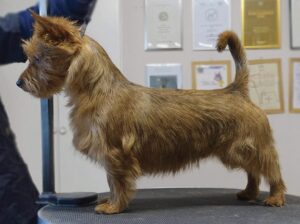
Controversy of tail docking in the Australian Terrier dog breed : Explore health, history, and perspectives on docked vs. undocked tails.
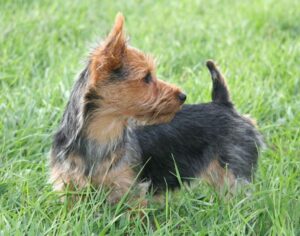
Explore the Australian Terrier head in this comprehensive guide. Learn about distinctive features, breed standards, and more.

Discover the hidden potential of Australian Terriers as remarkable performance dogs, excelling in Obedience, Agility, Barn Hunt, and more!
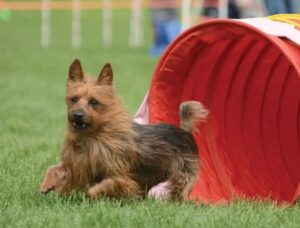
Explore the various Performance events you can participate in with your fast, agile, fearless, and self-confident Australian Terrier dogs.
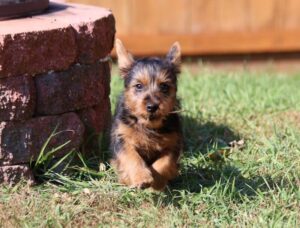
Julie Seaton is the breeder behind Temora Australian Terriers. Read about kennel’s beginnings, champions, puppies, photos & more!

"*" indicates required fields
Showsight Magazine–the world’s most influential purebred dog publication since 1992. Each issue reaches a global audience dedicated to preserving the history and health of purpose bred dogs. Filled with award-winning editorial focused on news and insights from the dog show community, top breeders, handlers, AKC Judges, and more!